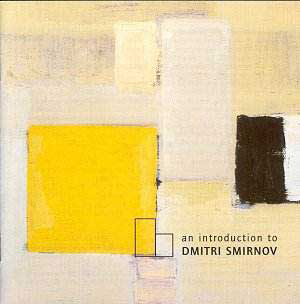Dmitri Smirnov has a considerable body of works in
almost every genre to his credit, including a great number of chamber
works of which the present release offers a generous selection from
both ends of his composing career to this day.
The Piano Trio No.1 Op.23 from 1977 is
the earliest piece here. It is in three movements said to symbolise
the three major stages of life: Origin and birth (at first hesitant,
the music progressively gains some considerable momentum), active life
(a rather nervous and lively Scherzo) and old age and death (an elegiac,
sometimes bitter-sweet movement with a faint echo of the Dies Irae).
The single movement Cello Sonata Op.25
was composed in 1978. It is a fairly concise piece of some substance
that sets out to "explore the extension of dodecaphony" (Frans
Lemaire) in adding quarter tones to its vocabulary; but the music nevertheless
retains its melodic character which seems to be a Smirnov trademark.
Smirnov studied with Edison Denisov. He was thus deeply
affected by Denisovís death in 1996 and composed his Elegy in
memory of Edison Denisov Op.97a in 1997. This piece exists in
two versions : Op.97a heard here is for solo cello and three crystal
glasses and Op.97b is for sixteen instruments. The piece is a deeply
felt elegy of great expressive power, At the very end the notes E-D-S
(= E flat) are eerily spelled out by the crystal glasses, either hit
or bowed, providing for an appeased, ethereal coda to this sometimes
impassioned, often moving piece.
The Violin Sonata No.3 "Es ist..."
Op.109 was composed in memory of Oleg Firsov, Elena Firsovaís
father and Smirnovís father-in-law. Again, this mostly elegiac work
is in three movements, i.e. a short nervous Scherzo framed by two substantial
slow movements. The subtitle Es ist... is taken from Bachís chorale
Es ist genug of which the first notes introduce each slow movement.
Smirnov completed his Postlude in memory Alfred
Schnittke Op.112 in 1998 after attending Schnittkeís funeral
in Moscow. The thematic material is based on musical monograms, not
only that of Schnittke, but also of many composers who were Ė or might
have been Ė important for Schnittke, a.o. Shostakovich (DSCH), Berg,
Bartók, Mahler and many others. The Postlude Op.112
has much in common with the Elegy Op.97a, besides being
also written for a stringed instrument. It obviously inhabits the same
emotional world. The Postlude Op.112 is thus for solo
violin and plays for a little over eleven minutes, but the track goes
on for another eight minutes with a piano piece which is later vocally
announced by Smirnov as being a performance of the Piano Sonata
No.4 Op.124 played by its dedicatee, Alissa Firsova, the composerís
daughter. Very interesting indeed to have thus two performances of this
piece, but then, why not an extra track?
The most recent piece here is the concise Piano
Sonata No.4 "String of Destiny" Op.124 composed as
recently as 2000 for Smirnovís daughter who has already played it repeatedly.
By comparison with the other pieces in this selection, and for obvious
reasons, this is a sunnier, livelier work in a youthfully light-hearted
vein. This should become a highly popular work.
Though clearly rooted in some late 20th
Century tradition, Smirnovís often impassioned music always aims at
direct communication, no matter how technically complex or sophisticated
it may be. Most pieces here are generally elegiac in mood; but the music,
rich in contrasts and often rising to forceful climaxes, never unduly
or morbidly lingers.
This superbly played, well recorded and well produced
release offers a quite attractive introduction to Smirnovís personal
sound world, and is warmly recommended. I now hope that some of Smirnovís
orchestral music will soon be recorded.
Hubert Culot


